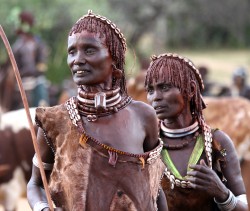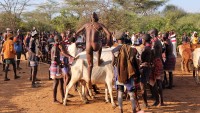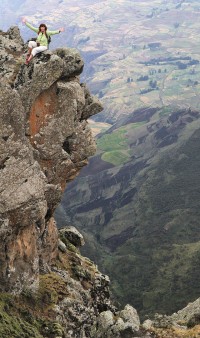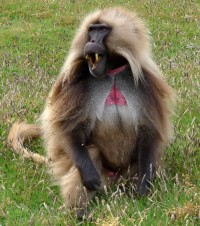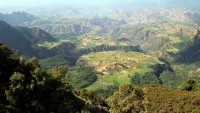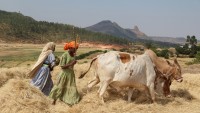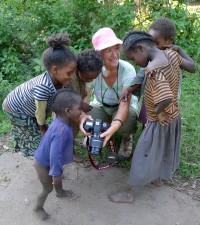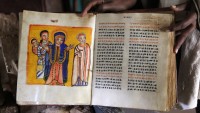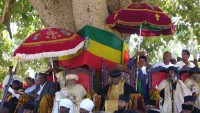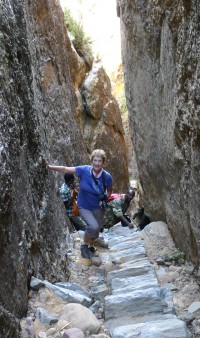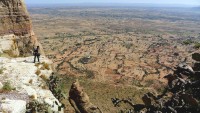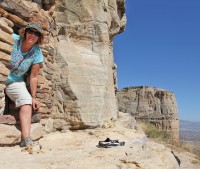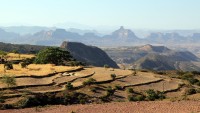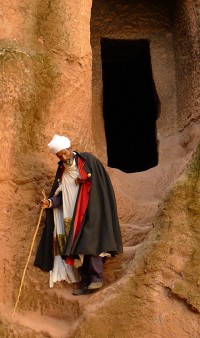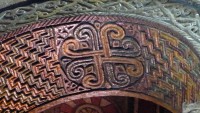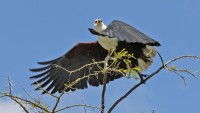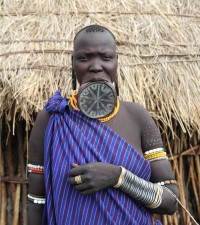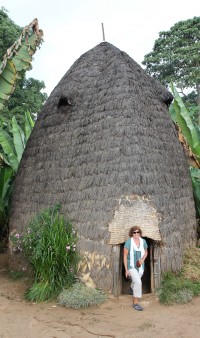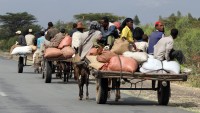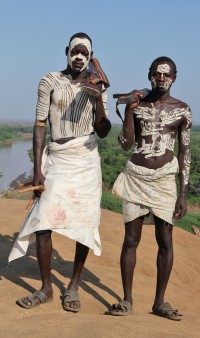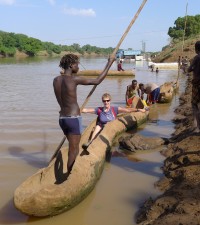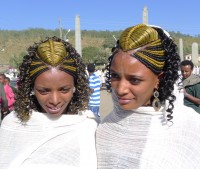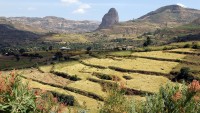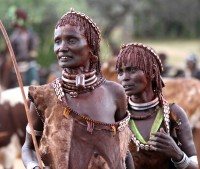"Ethiopia - a land like no other"
The northern landscape was breathtaking; dramatic mountains and vast highland tablelands riven by deep gorges and rivers, expansive tracts of subsistence farming stretching to the horizon and on every terraced ledge that the steep hillsides would allow. As the heartland of the Ethiopian Orthodox church, the religious celebrations and architecture were like nothing we’d ever experienced; Axum, Gheralta and Lalibela are unique living shrines, true to a faith that has remained virtually unchanged since the earliest days of Christianity.
Travelling south, our days focused more on wildlife and tribal communities as we followed the huge East African Rift Valley through the lush lakes region and onto the dry low-lying plains of the South Omo Valley. As we visited the various Omo tribes, observing their animist way of life and witnessing authentic customs and traditions, such as the bull-jumping and body scarification of the Hamer, the bizarre lip ornamentation of the Mursi and the incredible banana leaf architecture of the Dorze, we felt as if we had entered an African world of an earlier time, the way of life still largely untouched by outside influences.”
"Ethiopia is a traveller’s country, where distances can be long and the roads are sometimes rough. Regardless, the passing scene is always fascinating and at the end of each day we found ourselves in hotels and lodges that were surprisingly good, actually excellent in many cases and the food was great. A visit to Ethiopia is a true journey of discovery and if all you know about Ethiopia is derived from the media coverage of past famines and conflicts then, the reality of Ethiopia today will be a true revelation." Fay and Judy, reccy trip Nov 2012
Our itinerary will include.
Dramatic Landscapes
-
Simien National Park - A stupendous landscape that stretches as far as the eye can see. Featuring 1,000m high escarpments, rugged pinnacles and towering buttresses, this park is home to the endemic Gelada Monkeys, Walia Ibex and the Ethiopian Wolf and to the World’s highest density of Lammergeyer, the huge bearded-vulture. The park is a scenic gem, the short walks are exciting and wildlife viewing is rewarding.
-
Lake Tana / Blue Nile Falls - Lake Tana is Ethiopia’s largest lake and primary source of the Blue Nile. Walk to the Blue Nile Falls where the river drops over an impressive 45m high escarpment on its way to join the White Nile.
-
Rift Valley and the Lakes Region - South of Addis, enter the gigantic East African Rift Valley that slices the African continent from the Red Sea to Mozambique. Enjoy the lakes – swim in Lake Langano and go boating on Lake Chama to find the hippos, gigantic crocodiles and a huge variety of birds; 800 bird species are found in Ethiopia and many of these are found in the Rift.
-
Amazing Historical and Cultural Heritage Axum - The oldest city in Ethiopia and the holiest city of the Ethiopian Orthodox Church. According to Orthodox Christian belief, Axum is the home of the Ark of the Covenant. Visit Stelae Park and observe ancient religious rituals.
-
Rock Hewn Churches of Tigray – More than a hundred rock-hewn monasteries are clustered in the cliffs and promontories of the Tigray region. Climb/hike along incredible pathways to discover cliff-face rock-hewn churches and tiny chapels that are filled with medieval paintings and sacred artifacts. Some fantastic short walks are optional participation.
-
Lalibela – Unofficially recognized as the 8th Wonder of the Ancient World, the 12th and 13th century rock-hewn churches of Lalibela are unique. Totally carved below ground level, the churches have been a focal point for the devout highland people for eight centuries and today are living Christian shrines. People come to services and prayers each day and colourful traditional ceremonies can be observed. Behind the town is Asheton Maryam Monastery at almost 4,000m, the hike takes 4 hours return, it’s a fabulous morning walk for those who make the climb as the views are stunning
-
Lake Tana Monasteries - The Tana islands and peninsulas are home to a host of 14th Century Ethiopian Orthodox Monasteries, where the amazing untouched murals and artifacts are a visual encyclopedia of Ethiopia’s religious heritage.
-
Gondar – A medieval Capital city and Royal Compound of the 17th and 18th Century kings, Gondar is often referred to as the “Camelot of Ethiopia”
The Tribes of the South Omo valley
-
The South Omo Valley is home to a dozen or so animist tribes whose striking body adornments and traditional lifestyle scarcely acknowledge that the modern world exists. This region is a living anthropological museum, where the tribes still practice body scarring and body painting and create amazing ochre-coated hairstyles. To visit the Mursi, Hamer, Konso, Ari, Karo and Dorze people in their traditional villages, is a true once–in-a-lifetime experience
Draft Itinerary Outline (subject to change)
|
Day 1. Auckland to Flight, via Dubai |
|||
|
Day 2. Addis Ababa - arrive Dubai and transfer to the Addis Ababa flight, to arrive mid-afternoon. Welcome to Addis Ababa, Ethiopia’s capital city! The city lies in the central highlands at an altitude of 2,400m, making it the third highest capital in the world. |
|||
|
Day 3. Addia Ababa– Today, a full day sightseeing tour of the capital which will include the Ethnological Museum in the former palace of King Haile Silassie, the National (Archaeological) Museum, the superb Holy Trinity Cathedral and the Merkato - the largest open-air market in Africa. |
|||
|
Day 4. Addis to Debre Markos- (295Km) drive through the beautiful Entoto Hills towards Debre Markos; en route visit the monastery of Debre Libanos an important monastic center for Ethiopian Orthodox Christianity. Much of the drive is through gorgeous rural scenery punctuated by spectacular gorges such as the Muga and the Blue Nile Gorge |
|||
|
Day 5. Debre Markos to Bahir Dar – (255km) Drive to Bahirdar through the farmland of the Gojjam region, the homeland of the Agaw people, who build neatly fenced compounds around their tall circular homesteads. |
|||
|
Day 6. Bahir Dar – visit the Blue Nile Falls, before taking a boat trip on Lake Tana to visit one or two of the most famous monasteries. Ethiopian Orthodox monasteries have wonderful wall paintings that depict scenes from both the Old and the New Testaments, impressive collections of ancient crosses and illuminated Bibles written in Ge’ez Ethiopia’s oldest language. |
|||
|
Day 7. Bahir Dar to Gondar– (180km) Gondar became the Imperial Capital in 1632 and over the next 236 years many castles were built in the Royal Compound. The other places of interest include the Debre Birhan Trinity church with its truly magnificent roof and wall murals. |
|||
|
Day 8. Gondor to Simien National Park – (125km)), soon after leaving Gondar the spectacular mountain scenery begins, the Simien Mountains are truly dramatic. This Park became a World Heritage Site in 1978. |
|||
|
Day 9. Simien NP – Explore deeper and higher into the Park and later walk along a dramatic escarpment to the Jin Bar falls viewpoint. The scenery and drop-offs are truly awesome. Stroll amidst troops of Gelada monkeys as they forage in the late afternoon sun - they’ll totally ignore you. We have a very good chance of seeing herds of the endemic Walia Ibex and huge Lammergeyers flying in the thermals. |
|||
|
Day 10. Simien NP to Axum– (260km) - the road to Axum is a slow mountain road for much of the way with road work delays likely, but the scenery is just stunning! Founded between 200-700BC Axum was the seat of an Empire which extended across the Red Sea to Arabia. It traded with India and China, had its own alphabet and notation system, constructed great engineering works and dams and by the 4th century was recognised as one of the four great powers of the ancient world. Today Axum, considered to be the holiest city in Ethiopia, is visited by thousands of pilgrims each year. We plan to be there for the Maryam Tsion Festival which is scheduled for 29/30Nov (date not yet confirmed). At this time the city is bustling with pilgrims and the sights and ceremonies just have to be seen, to be believed. |
|||
|
Day 11. Axum – Visit Stelae Park which is the location of the largest single piece of stone ever erected. Just how this and the other stelae were brought from the quarry and erected is still not fully understood. See the tombs and castles of the kings, Axum Museum and Mariam Tsion Church, which is built on the site of Ethiopia’s first church. A tiny chapel within the church compound is believed by Ethiopian Orthodox Christians, to house the Ark of the Covenant, the original tablets of Moses. |
|||
|
Day 12. Axum to Gheralta - (190km) Attend the early morning ceremonies at Stelae Park and the Open Air Mass before departing for Gheralta in the heart of the Tigray region. Stop en route at the impressive pre-Axumite temple of Yeha which dates back to the 1st Century BC. Its well-preserved collection of ancient manuscripts is certainly worth seeing. |
|||
|
Day 13. Gheralta – In the morning hike up (opt.) the escarpment to the monastic church of Debre Mariam Korkor and continue around a narrow cliff path to a tiny rock church called Daniel's Prayer Room. What views! You can see forever, not only to the horizon but straight down the vertical cliffs to the valley below! Those who prefer can visit a more easily accessible rock-hewn church. A free afternoon. |
|||
|
Day 14. Gheralta to Mekelle – (140km) conclude our Tigray visits and activities before driving to Mekelle, one of the largest cities in Ethiopia. |
|||
|
Day 15. Mekelle to Lalibela – (360km) Lalibela flourished at the end of the 12th and beginning of the 13th centuries when King Lalibela built a series of rock-hewn churches and even a “Jordan River”, calling his creation New Jerusalem. Today, Lalibela is recognized as a UNESCO World Heritage Site, a remarkable living shrine. The construction and history of these churches will astound you, they are like no other. |
|||
|
Day 16. Lalibela - After breakfast, a 4hr hike (opt.,) to the church of Asheton Mariam which is located at 4,000m, high above the town. Those who don’t fancy the hike will have a free morning to enjoy the many craft shops and markets close to the hotel, there’s even a great Coffee Shop. After lunch visit the 2nd group of churches that are located south of the “Jordan River”. This group is comprised of Bet Emanuel, Bet Mercurios, Bet Abba Libanos and Bet Gabriel-Rafael. Each church is unique, all are superbly carved and most are decorated with well-preserved paintings. |
|||
|
Day 17. Lalibela - Visit the 1st group of six churches that lie in rock cradles, one behind the other: Bet Golgotha, Bet Mikael, Bet Mariam, Bet Meskel, Bet Danaghel and Bet Medhane Alem. Bet Medhane Alem, the largest, is built like a Greek temple and in one corner are three empty graves symbolically dug for the biblical patriarchs Abraham, Isaac and Jacob. Iconic Bet Giyorgis, the most elegant and majestic of all the churches, lies isolated in the southwest part of the village on a sloping rock terrace. It can only be reached through a tunnel. |
|||
|
Day 18. Lalibela to Addis Ababa – fly to Addis Ababa and after lunch complete our city sightseeing. |
|||
|
Day 19. Addis Ababa to Lake Langano– (205km) Drive south through rich horticultural lands to Lake Langano to stay overnight at beautiful Sabana Lodge. Enjoy an afternoon at the beach as the water is safe for swimming or go bird watching in the lodge grounds as they are home to a numerous colourful species, many of which are cheekily tame. |
|||
|
Day 20. Lake Langano to Arbaminch – (260km). Today, pass through one of the most colourful and scenic areas of Southern Ethiopia, a land that is inhabited by the Sidamo and Alaba tribes who were once nomads but are now farmers. Close to Arbaminch we will visit a Dorze tribal village. The Dorze were once warriors, but have turned to farming and weaving to earn a living. |
|||
|
Day 21. Arbaminch – (260km). A wonderful morning boat trip on Lake Chamo to see the “Hippo Pool” and the “Crocodile Market”, where large numbers of Nile crocodiles gather to bask in the sun (some up to 6m in length). The afternoon is free time. |
|||
|
Day 22. Arbaminch to Turmi – (250km) Today drive into the South Omo Valley. Our first stop will be the Konso village of Machekie. The Konso tribe are known for their terraced hill sides, fine woven materials and the carved totems which mark their grave sites. |
|||
|
Day 23. Turmi – Today, if it is available we will attend a bull jumping ceremony. This exciting and colourful ceremony marks the rite of passage to manhood for young Hamer warriors. As the ceremonies are not tourist events, we can’t guarantee if one will be happening during our stay. However so far, our luck has been in, with two visits - two ceremonies. Our daily schedule in Southern Ethiopia may change to suit the location and timing of a ceremony. |
|||
|
Day 24. Turmi to Jinka– (128km) Visit a local market where Hamer ladies can be seen, dressed in their traditional skin clothing and their distinctive ochre-coated braided hair style. These markets are a great opportunity to buy genuine tribal artifacts. The Hamer are fine looking people, both men and women taking great pride in their appearance, shaving and coloring their hair, oiling their bodies and decorating themselves with beads and bracelets. After lunch drive to Jinka, where we will visit an Ari tribal community. |
|||
|
Day 25. Jinka to Arbaminch - (230km) This morning we will visit the Mursi tribe in the Mago National Park. The Mursi are the most infamous of the Omo tribes because of their practice of inserting clay plates into the lower lips of their women. Our guide will explain the various cultural aspects of the tribe and you will be able to take photographs and interact with the people. |
|||
|
Day 26. Arbaminch to Lake Langano (300km) – Drive to Sabana Lodge at Lake Langano for our final overnight stop. Arrive mid-afternoon, free time to relax and prepare for our journey home. Tonight, a farewell celebration with our drivers and guides. |
|||
|
Day 27. Lake Langano to Flight - After breakfast drive back to Addis Ababa airport to connect with our late afternoon flight to Dubai. |
|||
|
Day 28 Dubai to Flight – A morning departure for Auckland |
|||
|
Day 29. Auckland – arrive late morning |
1) The above is the proposed schedule of what is planned, but because of the nature of adventure travel, changes may become necessary at any time.
General Notes
Daily Schedule: Please be aware that most days involve around 8/9hrs on-the-go including sights/visits and activities, comfort and lunch breaks, photo stops and drive-time, however on one or two days this will extend out to 10+hrs. Days will generally start between 7:30 - 8:30 and reach or return to our hotel between 16:00 - 17:00. However, the passing scene is always riveting, with varied scenery and sites, and lots of animals and people going about their daily lives. Most people find that snoozing is rarely an option, as there is just too much to see! A few hours of free -time are built-in every few days, but otherwise be prepared for a full-on experience of Ethiopia – it’s vast, it’s varied and totally AMAZING!
Transport: We will use a private bus charter for the northern loop Addis to Lalibela (16days), a flight from Lalibela to Addis, followed by 4WD Land Cruisers for the southern loop back to Addis (10 days). Roads can be tar sealed or shingle (dusty), sometimes bumpy and slow due to road works and/or rain damage, although most of the time a reasonable pace can be maintained. Both 4WDs and the bus will be air-conditioned. Public toilets en route are few and far between so “bush stops” will be made as requested.
Luggage: A medium sized wheelie bag (no more than 65/70ltrs capacity, measuring 130/132 linear cm) works well, but for ease of handling please keep baggage as light as possible (12 -14kg). Bag porterage is not included in most places. Take a light day pack for sightseeing and day walks.
Accommodation: Hotels/Lodges - Twin/double rooms the norm. Hotels / Lodges anticipated are essentially Star**/***. However, the hotel in Debark - the 2nd night at Simien National Park (1n) is basic and simplistic.
We are not able to offer single rooms unless a supplement is paid, US$1,100. Should uneven booking numbers require, if appropriate, a triple room will be arranged and its occupancy shared around those who are not travelling with a specific friend or family member.
Meals: All breakfasts and 15 dinners included, except for dinner and breakfast in Dubai. Lunches not included, are normally taken in local restaurants en route. Lunch meals are relatively cheap, around US$12 + for a simple meal without drinks. Food is good and tasty, with a range of soft drinks and an excellent beer is available. No meals eaten at airports are included.
Altitude Range: Highest sleeping location is 3,200m (1 night only) all others are below 2,600m, with most below 2,200m. Your day time travel reaches 4,000m. Please check that your insurance covers you at this altitude, not all policies do.
Weather – Anticipate sunshine most days, generally all day, with comfortably warm temperatures in the north, but in the South it can get rather hot (30s+), especially for the 2 to 3 days when we are in the extreme south. Nights can be cool in the north, even cold in a couple of places, so a jacket and set of thermals should be taken. Rain is possible, but as we will be travelling in the dry season, it shouldn’t bother us too much. A light jacket and umbrella is recommended.
Dress is conservative – Women should not show bare knees or shoulders, so no singlets/sleeveless tops or pants/skirts shorter than mid-calf. Men, no bare chests and as wearing shorts is considered extremely odd, stick to longs and ¾ pants or long shorts at the very least. Generally light weight pants/skirts and t-shirts are the order of the day, with a set of warm layer-up clothing and jacket for the cooler mountain locations.
Walks and Hikes: The itinerary will include on-foot sightseeing. In addition, there will be some short walks of ½ to 1hr+, with a couple of hikes of 2 to 4hrs. While most walks are not difficult, a couple are only suitable for those who enjoy scrambling and have a good head for heights. When there are longer more technical walks we try offer an alternative activity as well.
PRICE WILL INCLUDE - Air fares Auckland to Addis Ababa return, bus, 4WD transport and a local flight, accommodation in twin/double rooms, meals as listed, a daily sightseeing / activities / excursions / hikes / entries / and a Basic Group tip fund* for drivers and local guide/s. * Please note that this fund will need to be supplemented by US$50 per person.
PRICE DOES NOT INCLUDE. All unspecified meals, activities or services, personal and room tipping and a $50 group tipping fund contribution (collected in Addis Ababa). Any personal spending, insurance, visas and any other documentation required, any flight and airport related taxes / surcharges that may occur en route and any additional costs incurred by travel disruption or delay. A visa on arrival is required, currently US$52.
INSURANCE / Cancellation. We strongly recommend that you arrange your Travel Insurance at the time of paying the full Deposit as Flight, Transport charter/tickets, Accommodation or Event/site entry related payments are often non-refundable once paid to the service provider on your behalf. Service providers may impose cancellation or change fees and some services may be totally non-refundable. Be sure that your Insurance covers deposits made prior to departure if a cancellation is required and your travel up to 3,200m.
FACT FILE
Trip Code: ET
Date: Currently not scheduled
Duration: 29 days
Party: min., 10 max., 16 + leader
Status:

